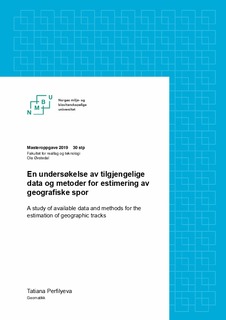| dc.contributor.advisor | Øvstedal, Ola | |
| dc.contributor.author | Perfilyeva, Tatiana | |
| dc.coverage.spatial | Norway | nb_NO |
| dc.date.accessioned | 2019-10-16T09:09:56Z | |
| dc.date.available | 2019-10-16T09:09:56Z | |
| dc.date.issued | 2019 | |
| dc.identifier.uri | http://hdl.handle.net/11250/2622473 | |
| dc.description.abstract | Friluftsliv er svært populært blant nordmenn. Folk liker å gå på tur og trenger derfor kart og markerte ruter. Kartverket har utarbeidet en database for tur og friluftsruter, og har dermed et stort behov for å utvide og vedlikeholde den jevnlig. Dette krever mye ressurser. Som en løsning på problemet kan det utvikles nye teknikker for å samle og bearbeide data. Denne oppgaven har gjennomført kvalitetsundersøkelse av mulighetene til å forbedre nøyaktigheten på tur og friluftsruter ved hjelp av forskjellige datakilder og et program basert på minste kvadraters metode. Datakilder som ble brukt i oppgaven er N50 kart, tur og friluftsruter, orienteringskart og data som ble samlet ved hjelp av CPOS, mobiltelefon og løpeklokker.
Oppgaven tok sikte på å undersøke om forskjellige kilder som N50 kart, orienterings kart, data fra løpeklokker bidrar til posisjonsnøyaktighet på tur- og friluftsruter, og å undersøke muligheten til å bruke Fysak som Kartverkets egen programvare for å kombinere datakilder, bestemme hvilke kilder bidrar mer enn de andre, og til slutt hvilke kilder som kan brukes for å effektivisere registrering av nye ruter og utvide databasen. Til dette formålet ble det samlet data og estimert punkter i ulike kombinasjoner, hver for seg og sammen og laget fasit for å sammenligne med.
Resultatene viser at posisjonsnøyaktighet på tur- og friluftsruter blir bedre med bidrag fra N50 kart, orienteringskart og CPOS, at fysak kan brukes for å sample data med 1 meter og lagre data i riktig format med nøyaktighetsmål, at CPOS bidrar mest til posisjonsnøyaktigheten, og at data fra mobiltelefon, løpeklokkene, N50 kart og orienteringskart kan brukes til å forbedre og utvide databasene. | nb_NO |
| dc.description.abstract | Outdoor recreational activities are very popular among people in Norway. The demand for accurate and updated georeferenced trails is therefore high. Over the last years, The Norwegian mapping authority “Kartverket” has developed a national database containing a high number of georeferenced trails, data which require regular updating and maintenance. Updating and maintenance can require much work and resources for Kartverket. Due to technological advancements, the database is also continually expanding as more and better technology is available to both consumers and professionals. Large amounts of data combined with a high demand of accuracy suggest developing and testing new methods for collecting and processing the data more efficiently. This thesis has explored the possibilities of improving the accuracy of the data from this database by performing a quality assessment on a data-processing-program which is based on the method of least squares. This program makes use of several data sources including N50 maps, trail maps, orienteering maps, and data gathered with GNSS technology such as CPOS, mobile phones and running watches.
The thesis aimed at examining the possibility of improving the accuracy of the data in Kartverkets database “tur-og friluftsruter” by utilizing and combining several sources of data, such as N50 maps, orienteering maps and GNSS data collected with mobile phones and running watches, the possibility of using Kartverkets own software Fysak for this purpose, decide which of the data sources contribute to the accuracy the most, and what data sources which can be used for streamlining the process of registering new trail routes in the database. To accomplish these goals, large amounts of data from the same trail were collected and processed, and eventually compared to a reference of high accuracy.
The results from this thesis show an improvement in accuracy in the georeferenced trail routes in “tur- og friluftsruter” by combining N50 maps, orienteering maps and CPOS, that the software Fysak can be used for sampling points with a spacing of 1 meter along a line and store the points with the right accuracy in the correct format, that CPOS has the highest contribution to the resulting accuracy, and that the data collected with GNSS mobile phones, GNSS running watches, N50 maps and orienteering maps can be used to improve and expand the “tur-og friluftsruter” database. | nb_NO |
| dc.language.iso | nob | nb_NO |
| dc.publisher | Norwegian University of Life Sciences, Ås | nb_NO |
| dc.rights | Attribution-NonCommercial-NoDerivatives 4.0 Internasjonal | * |
| dc.rights.uri | http://creativecommons.org/licenses/by-nc-nd/4.0/deed.no | * |
| dc.subject | Geomatikk | nb_NO |
| dc.subject | Minste kvadraters metode | nb_NO |
| dc.subject | GNSS | nb_NO |
| dc.title | En undersøkelse av tilgjengelige data og metoder for estimering av geografiske spor | nb_NO |
| dc.title.alternative | A study of available data and methods for the estimation of geographic tracks | nb_NO |
| dc.type | Master thesis | nb_NO |
| dc.subject.nsi | VDP::Teknologi: 500 | nb_NO |
| dc.source.pagenumber | 83 | nb_NO |
| dc.description.localcode | M-GEOM | nb_NO |

